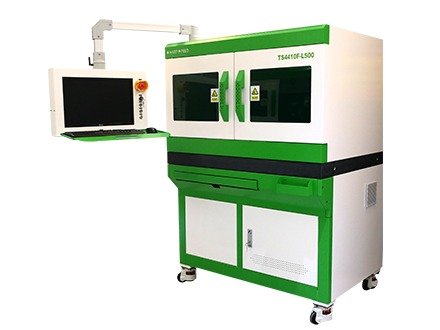Introduction
In the field of electronics manufacturing, achieving precise resistance values is a critical aspect of ensuring the functionality and longevity of components. One of the most efficient methods of achieving this level of precision is through laser trimming equipment. Whether working with thin film resistance or thick film solutions, laser trimming has become an indispensable tool for fine-tuning the performance of resistors and other electronic components. In this article, we will delve into how laser trimming equipment works, its benefits, and how to choose the right system for both thin film resistance and thick film solutions.
What Is Laser Trimming Equipment?
Laser trimming equipment is specialized machinery that uses a focused laser beam to precisely trim or cut away material from resistors and other electronic components. By carefully removing specific areas of material, this process adjusts the electrical resistance of the component to the required value. This technology is particularly valuable because it allows for micro-adjustments, ensuring that components meet strict tolerances without the need for mechanical contacts or physical adjustments.
The laser trimming process is highly effective for both thin film resistance and thick film solutions, two of the most commonly used resistor technologies. The difference lies in the thickness of the material being trimmed and the type of applications they are used for.
Understanding Thin Film Resistance and Thick Film Solutions
- Thin Film Resistance
In thin film resistance, a thin layer of resistive material is deposited onto a substrate, such as glass or ceramic. The layer is typically just a few micrometers thick, and its electrical properties depend on the material’s composition and the layer’s dimensions. Thin film resistors are known for their high precision and stability, which makes them ideal for applications requiring extremely accurate and reliable performance, such as in medical devices, high-frequency electronics, and sensors.
When it comes to thin film resistance, laser trimming equipment is used to adjust the resistance by vaporizing minute sections of the thin layer. Since the material is so thin, the laser must be finely controlled to avoid damaging the underlying substrate while still removing enough material to achieve the desired resistance.
- Thick Film Solutions
On the other hand, thick film solutions involve the deposition of resistive material that is much thicker, often tens of micrometers, and is typically used in power electronics or automotive applications. The resistive material is printed onto a substrate, often using a screen-printing process. Thick film resistors are generally more robust and can handle higher power levels and greater temperature variations compared to thin film resistors.
When trimming thick film solutions, laser trimming equipment uses higher-powered lasers to remove larger sections of material. This process is also highly controlled, as the laser must be able to handle the thicker material without damaging the surrounding substrate or affecting the performance of other components.
How Laser Trimming Works
Laser trimming is a non-contact process that uses a focused laser beam to remove material from a resistor’s surface, adjusting its resistance. The laser vaporizes small areas of the resistor, removing material without physically touching it, which helps preserve the integrity of the component. The precise nature of the laser allows for very small and accurate adjustments to the resistor’s resistance, typically on the order of milliohms.
- Laser Trimming for Thin Film Resistance
For thin film resistance, the laser trimming system focuses on precisely removing small portions of the thin film material. The resistive layer, which is very thin, needs to be altered just enough to meet the required resistance value. Since the material is so delicate, laser trimming equipment needs to operate with extremely fine control to avoid excess heat transfer to the substrate. This precision ensures that no damage is done to the underlying surface while achieving the desired resistance.
- Laser Trimming for Thick Film Solutions
In thick film solutions, the laser trimming process involves a bit more power to remove the thicker resistive layers. Here, the laser must penetrate and vaporize more material to alter the resistor’s resistance. This can be used to correct deviations in the manufacturing process or to fine-tune resistance values during production. The ability to adjust thick film solutions with precision is crucial for high-power applications, where even small changes in resistance can impact the overall performance of the device.
Advantages of Laser Trimming Equipment
The use of laser trimming equipment offers a variety of benefits over traditional trimming methods, such as mechanical or manual processes:
- High Precision and Accuracy
Laser trimming provides unmatched precision, ensuring that the resistance values are adjusted exactly as required. The fine control over the laser allows manufacturers to meet stringent tolerance requirements, which is especially important in industries like aerospace, automotive, and medical devices, where component reliability is critical.
- Non-Contact Process
Because laser trimming does not involve physical contact with the component, there is less risk of damaging delicate parts. The process is highly controlled, and since no force is applied to the component, the risk of mechanical stress, which could lead to fractures or other issues, is minimized.
- Speed and Efficiency
Laser trimming equipment can perform trimming processes quickly, making it ideal for both low-volume prototyping and high-volume production. The non-contact nature of the process also allows for quicker adjustments without the need for additional tooling or setup time.
- Flexibility
Laser trimming can be used on a wide range of materials, including metals, ceramics, and polymers, making it a highly versatile tool in electronics manufacturing. It is particularly useful for thin film resistance and thick film solutions, offering manufacturers a flexible solution for a variety of resistor types.
- Reduced Waste
Laser trimming minimizes material wastage, as it only removes the precise amount needed to achieve the desired resistance. This is in contrast to traditional mechanical trimming methods, which can generate more waste or require excess material removal to reach the target resistance.
Applications of Laser Trimming Equipment
- Thin Film Resistance Applications
Thin film resistors are used in a variety of high-precision applications, such as in medical devices, sensors, and precision electronics. Laser trimming is particularly useful for applications that require extremely small and accurate resistance adjustments, as it allows for fine-tuned customization without compromising the integrity of the components.
- Thick Film Solutions Applications
Thick film resistors are typically used in power electronics, automotive systems, and industrial applications. Laser trimming ensures that even larger resistive elements can be precisely adjusted to meet specific resistance requirements. This is crucial in high-power systems, where component accuracy can significantly affect the overall performance of the device.
How to Choose the Right Laser Trimming Equipment
When selecting laser trimming equipment, there are several factors to consider to ensure the system meets your production needs:
- Laser Power
The power of the laser determines the type of materials it can trim and the thickness of the layers it can handle. For thin film resistance, lower-powered lasers are typically used to ensure fine control, while for thick film solutions, higher-powered lasers may be necessary to handle the thicker resistive layers.
- Precision and Control
The accuracy of the laser system is crucial for meeting tight resistance tolerances. Look for equipment that offers fine control over the laser’s intensity, focus, and positioning to ensure that small adjustments can be made without affecting other components.
- Speed and Throughput
If you’re working in a high-volume production environment, it’s essential to choose laser trimming equipment that can handle the throughput required. Faster trimming systems with high precision can significantly improve production efficiency.
- Compatibility with Materials
Ensure the laser trimming equipment you choose is compatible with the materials used in your resistors, whether they are thin film or thick film solutions. Some systems may be better suited for specific materials, so it’s important to select the right one based on your application.
Conclusion
In conclusion, laser trimming equipment is an essential tool for achieving precise resistance values in both thin film resistance and thick film solutions. Whether for medical devices, sensors, or power electronics, laser trimming ensures that components meet the highest standards of accuracy and reliability. By understanding the requirements of your application and selecting the right equipment, you can improve the performance and durability of your electronic components while maintaining manufacturing efficiency.















































